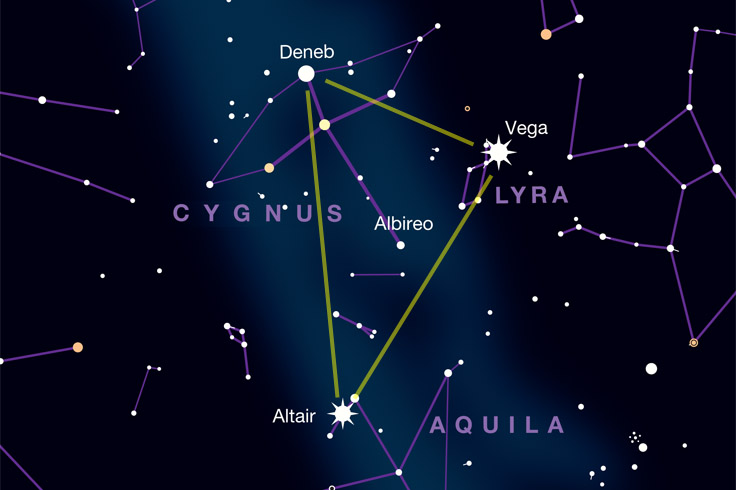The calendar might say “September,” but now is the perfect time to explore the Summer Triangle. Find your way with this month’s Sky Tour podcast.

Listen Here:
Podcast: Play in new window | Download
Subscribe: Apple Podcasts | Google Podcasts | Spotify | Email | RSS | More
This month’s Sky Tour astronomy podcast tells you “what’s up” in the evening skies. No experience or equipment is necessary — just download or stream the audio file and take it with you outside.
If you live in the Northern Hemisphere, by now you’ve surely noticed that the daylight hours are getting shorter. Back in July, the change was oh so subtle. But now we’re losing a couple minutes of Sun each day, more so if you live farther north. The equinox falls on September 22nd at 3:21 p.m. Eastern Daylight Time. On this date the Sun momentarily shines directly down on Earth’s equator as it heads south in declination. Equinox comes from the Latin word aequinoctium, meaning “equal nights” — days and nights everywhere are both 12 hours long, and the Sun rises due east and sets due west no matter where you are.

Sky & Telescope
Summer might be ending astronomically for the Northern Hemisphere, but most of summer’s stars can still be seen. Topping the list is the trio of bright stars collectively called the Summer Triangle. Finding them is easy, even if your backyard is hopelessly awash with light pollution. Lift your gaze up, way up, to find a bright star that’s almost directly overhead. That’s Vega in the constellation Lyra, the Lyre.
If you’re looking up at Vega, you should also be seeing the other two corners of the Summer Triangle. To the south of Vega is Altair, the alpha star in the constellation of Aquila, the Eagle. The third star is about two fists from Vega toward east. That star is Deneb, which marks the tail of a graceful swan, the constellation Cygnus. At the swan’s other end is a medium-bright star called Albireo, and it lies close to the middle of the Summer Triangle.
These late-summer evenings also offer a chance to spot Venus, Jupiter, and Saturn in the hours after sunset. For easy help finding them, just download this month’s Sky Tour podcast. In fact, our monthly stargazing podcast offers a guide to many more stars and constellations in the nighttime sky. It’s perfect for anyone who can't tell Polaris from Pegasus! Just download or stream the Sky Tour podcast, head outdoors, and let your September night-sky adventure begin!
 0
0
Comments
You must be logged in to post a comment.